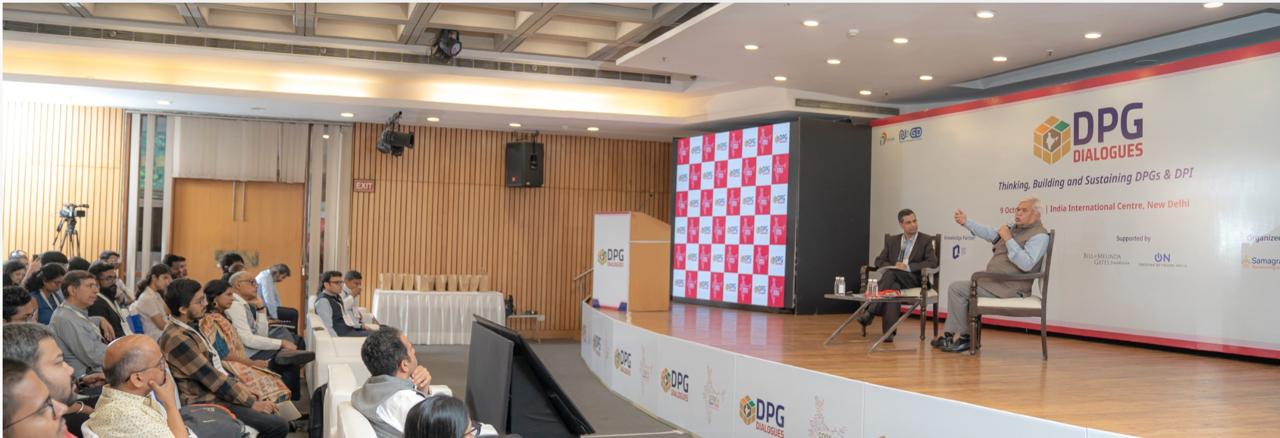
Leveraging DPGs
At SamagraX, we are addressing prevalent gaps in governance and public service delivery, by shaping purpose-fit 'Digital Public Goods' (DPGs) to enhance efficiency, transparency, and service coverage across domains.
DPGs democratise the use of advanced technology and assist in strengthening government initiatives to the full extent. DPGs are easy-to-deploy and can provide increased visibility into policy implementation, streamline communications and transform how government administrators monitor, manage, and optimise public programs.
Products delivered
Universal Communications Interface
A communications interface that brings high configurability and reduces coding requirements in creating conversational flows across governance use cases.
Core Problem
Constant engineering intervention is required to set up and manage communication channels for governance services, making it difficult to efficiently reach and engage end-users across platforms like WhatsApp, SMS, and email.
How it works
UCI employs an adapter-based abstraction layer, enabling seamless integration with various communication channels. It allows users to configure and deploy conversation flows over chatbots, without redundant coding requirements. End-users can activate conversations with a UCI bot with a simple text, and start interacting to resolve their queries, discover content, or share information.
The Impact
UCI removes the information asymmetry between service providers and end-users, facilitating better core interactions across domains. For instance, it can help teachers take and review student quizzes via WhatsApp, and farmers receive crop-specific advisory via SMS. UCI bots offer custom reports, content discovery, and alerts — eliminating challenges and driving use cases across domains.
cQube
cQube is a pre-packaged, configurable DPG solution that offers insights, nudges, and role-based actions into schemes and programs across domains to improve their monitoring.
Core Problem
Government administrators often find it challenging to effectively monitor program delivery across domains.
How it works
cQube features pre-defined, Bharat-specific contextual indicators for key government stakeholders and program owners to monitor and drive program objectives. The solution is built on an easy-to-deploy, scalable interface and uses modular components that are interoperable with existing systems, enabling simple integrations.
The Impact
cQube features pre-defined, Bharat-specific contextual indicators for key government stakeholders and program owners to monitor and drive program objectives. The solution is built on an easy-to-deploy, scalable interface and uses modular components that are interoperable with existing systems, enabling simple integrations.
Stencil
An open-source boilerplate offering a backend framework and essential frontend components to simplify the development of government websites and applications.
Core Problem
The complex and time-consuming nature of setting up the foundational components for web development, particularly when building scalable microservices and applications for government systems.
How it works
Stencil offers a comprehensive repository with multiple features like Prisma for database interactions, nodemailer for mailing capabilities, and more, enabling them to build functional microservices. Developers can simply clone the Stencil repository, configure the environment, and develop backend systems and microservices that allow database integrations, mailing setups, file uploads, and a lot more.
The Impact
Stencil empowers developers to build scalable and efficient government websites and applications. Its ready-to-use boilerplate and built-in features reduce setup time, allowing developers to focus on writing service-specific business logic instead of common tooling. This straightforward workflow ensures the quick and effective deployment of microservices for government systems.
Saral
An AI-enabled, OCR+ application that converts physical information to digitally structured data, enabling quick data collection and analysis.
Core Problem
Manually capturing and processing information from physical documents is a time-consuming and error-prone task, especially when digitising large-scale data such as student assessments and admission forms.
How it works
The solution replaces old answer sheets with state-wide standardised OMR sheets, which teachers can scan using the Saral App and digitise the responses. Teachers can assess responses across the platform, and view a detailed results and performance dashboard for simpler student evaluations. We envision the Saral app to contribute to multiple similar use cases across domains.
The Impact
Currently, the app helps teachers digitise student admission forms and assessment processes. It enables large-scale student assessments, digitising the evaluation, result generation, and performance tracking processes. With a built-in AI, the Saral app makes student-level data collection a lot faster and allows teachers to directly iterate assessments over the platform.
